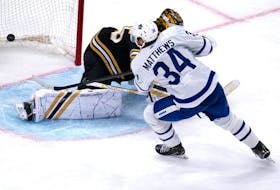By Jennifer Hoegg
A boy wanted to play.
That’s how the story of what may be the world’s oldest hockey stick began near Cape Breton’s Pottle Lake around 180 years ago.
Mark Presley now wants that stick to help today’s kids have an opportunity to play, too.
The Berwick man is making a number of local appearances with the stick to raise money for Canadian Tire’s Jump Start program.
“It’s a really natural fit,” he said. “The Moffat Stick was created so kids can play.”
Sports and recreation opportunities are “critical to healthy mind, body and spirit,” Presley said, “but one in three homes are not able to enroll their kids in sport and recreation.”
Jump Start helps kids aged four to 18 access a “full range of opportunities. Allowing them to be kids.”
Carved from a piece of sugar maple, the stick is child-sized and has a patina of age, along with flakes of different paint colours. The blade is curved - more like a modern hockey blade, but less than a j-shaped field hockey stick – and the blade gets thicker as it curves, best to fling the leather-bound ball of the era across the ice.
“The magnificence is in the design specifications,” he said.
Presley, a former social worker and antique store-owner, first saw the stick in 2000 in North Sydney and returned to the Cape Breton barbershop to buy the stick eight years later for $1,000.
After speaking with the stick’s previous owner, the late Charlie Moffat, when he was in his 90s, Presley traced the artifact through the Moffat family line.
Charlie said his father, Warren, and grandfather, Thomas, played with the stick, but initials into the stick were “WM.” Who was the stick made for?
With the help of a little historical research and a visit to a lab at Mount Allison University - where tree rings and five layers of paint were examined – he was able to find a probable answer.
“It was absolutely crafted between 1835 and 1838,” Presley said, which puts it in the young hands of Thomas’ older brother, William “Dilly” Moffatt, born in 1829.
Who carved it is a bigger mystery, but Presley thinks he knows the answer.
“I have an instinctual sense it was crafted by the Mi’kmaq,” he said. “They were master woodcrafters of their era.”
Presley said there is a local history of Mi’kmaq-carved sticks, specifically connected to a hockey stick manufacturing company called Pirate, which operated pre-1920 in Wolfville.
Whatever its origins, the Cape Breton-carved stick is a rare surviving example of the evolution of the game, Presley said.
“It’s older than hockey,” Presley pointed out. When the stick was carved, the game was called hurley on ice.
“I hope the stick provides people with a little bit of wonderment,” Presley said, of his plans for local public appearances.
If anyone asks him who last played hockey with the stick, that’s an easy answer.
Presley asked Charlie if he played with it on Pottle Lake.
“No boy, I’d get store-bought sticks at Christmas,” the old man replied.
See the stick
Jan. 25 – Acadia Axemen hockey game.
7 p.m., Acadia Athletics Complex, Wolfville
Jan. 26 - Canadian Tire New Minas
10 a.m. to 3 p.m., New Minas
Feb. 8-10 - Long Pond Heritage Classic, Windsor. WEBLINK: www.longpondclassic.com
By Jennifer Hoegg
A boy wanted to play.
That’s how the story of what may be the world’s oldest hockey stick began near Cape Breton’s Pottle Lake around 180 years ago.
Mark Presley now wants that stick to help today’s kids have an opportunity to play, too.
The Berwick man is making a number of local appearances with the stick to raise money for Canadian Tire’s Jump Start program.
“It’s a really natural fit,” he said. “The Moffat Stick was created so kids can play.”
Sports and recreation opportunities are “critical to healthy mind, body and spirit,” Presley said, “but one in three homes are not able to enroll their kids in sport and recreation.”
Jump Start helps kids aged four to 18 access a “full range of opportunities. Allowing them to be kids.”
Carved from a piece of sugar maple, the stick is child-sized and has a patina of age, along with flakes of different paint colours. The blade is curved - more like a modern hockey blade, but less than a j-shaped field hockey stick – and the blade gets thicker as it curves, best to fling the leather-bound ball of the era across the ice.
“The magnificence is in the design specifications,” he said.
Presley, a former social worker and antique store-owner, first saw the stick in 2000 in North Sydney and returned to the Cape Breton barbershop to buy the stick eight years later for $1,000.
After speaking with the stick’s previous owner, the late Charlie Moffat, when he was in his 90s, Presley traced the artifact through the Moffat family line.
Charlie said his father, Warren, and grandfather, Thomas, played with the stick, but initials into the stick were “WM.” Who was the stick made for?
With the help of a little historical research and a visit to a lab at Mount Allison University - where tree rings and five layers of paint were examined – he was able to find a probable answer.
“It was absolutely crafted between 1835 and 1838,” Presley said, which puts it in the young hands of Thomas’ older brother, William “Dilly” Moffatt, born in 1829.
Who carved it is a bigger mystery, but Presley thinks he knows the answer.
“I have an instinctual sense it was crafted by the Mi’kmaq,” he said. “They were master woodcrafters of their era.”
Presley said there is a local history of Mi’kmaq-carved sticks, specifically connected to a hockey stick manufacturing company called Pirate, which operated pre-1920 in Wolfville.
Whatever its origins, the Cape Breton-carved stick is a rare surviving example of the evolution of the game, Presley said.
“It’s older than hockey,” Presley pointed out. When the stick was carved, the game was called hurley on ice.
“I hope the stick provides people with a little bit of wonderment,” Presley said, of his plans for local public appearances.
If anyone asks him who last played hockey with the stick, that’s an easy answer.
Presley asked Charlie if he played with it on Pottle Lake.
“No boy, I’d get store-bought sticks at Christmas,” the old man replied.
See the stick
Jan. 25 – Acadia Axemen hockey game.
7 p.m., Acadia Athletics Complex, Wolfville
Jan. 26 - Canadian Tire New Minas
10 a.m. to 3 p.m., New Minas
Feb. 8-10 - Long Pond Heritage Classic, Windsor. WEBLINK: www.longpondclassic.com








